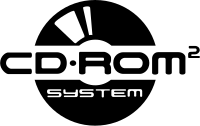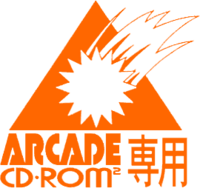Difference between revisions of "CD-ROM² systems"
From NEC Retro
| Line 66: | Line 66: | ||
===LD-ROM²=== | ===LD-ROM²=== | ||
| + | [[File:LDROM2 logo.png|200px|right]] | ||
The LD-ROM² format is a similar format to the above but is this time distributed on LaserDisc, specifically for use with the [[LaserActive]] by Pioneer using the NEC PAC (PAC-N10/PAC-N1) add-on. | The LD-ROM² format is a similar format to the above but is this time distributed on LaserDisc, specifically for use with the [[LaserActive]] by Pioneer using the NEC PAC (PAC-N10/PAC-N1) add-on. | ||
Revision as of 14:30, 1 January 2017
This short article is in need of work. You can help NEC Retro by adding to it.
In December 1988 NEC began to release video games on CD-ROM for its PC Engine console. These CD-ROM² systems, beginning with the appropriately titled CD-ROM² would take a number of forms over the coming years, complementing the base system and its range of games on HuCard.
The complex nature of the CD-ROM² line has led to NEC Retro grouping all CD-based PC Engine variants under the same umbrella term. In reality there are three CD-ROM² formats; "CD-ROM²" (シーディーロムロム), "Super CD-ROM²" (スーパーシーディーロムロム) and "Arcade CD-ROM²" (アーケードシーディーロムロム). Theoretically all CD-ROM² systems can run software of all three formats, however some require "system cards" to enable this functionality.
Unlike HuCards, PC Engine CD-ROMs are not region locked, and therefore will function on their TurboGrafx-16 equivalent units and vice versa. The system cards however, are region locked, and so may require extra adapters to function.
Despite the stylising of the name, "CD-ROM²" is officially pronounced "CD-ROM ROM", as opposed to "CD-ROM squared" or "CD-ROM two".
Contents
Formats
CD-ROM²
The original CD-ROM² standard debuted alongside the CD-ROM² hardware in December 1988. All CD-ROM² systems can run CD-ROM² games natively.
In North America this format was simply marketed as games for the TurboGrafx-CD (or occasionally "Turbo CD games"), as at the time only one format existed.
Technical specifications
List of games
Super CD-ROM²
The Super CD-ROM² debuted in December 1991 (with the Super CD-ROM² unit), and quickly became the de facto standard for CD-based PC Engine games moving forward. Initially all PC Engine hardware required the Super System Card to access the Super CD-ROM² library - the contents of the card were later built into the PC Engine Duo and its derivatives.
This format also made it to North America, however a change in distributors and the low key nature of the TurboGrafx-16 library made the situation less clear cut. While the Super System Card was still an option for TurboGrafx-16 users, games were often simply marketed as "TurboDuo games", i.e. built specifically for that console, rather than a TurboGrafx-16 + TurboGrafx-CD combo. Some regular CD-ROM² games were retrospectively re-labled as such to try and alleviate some confusion.
Technical specifications
List of games
Arcade CD-ROM²
A third format, the Arcade CD-ROM² debuted in March 1994, towards the end of the PC Engine's life. Unlike the Super CD-ROM² format, Arcade CD-ROM² technology was never built into hardware, so always requires the use of an Arcade Card Pro (for older hardware) or Arcade Card Duo (for systems with Super CD-ROM² support built-in (typically a PC Engine Duo, hence its name)).
Arcade CD-ROM² games were only officially released in Japan, although with the correct setup, will also function on North American systems.
Technical specifications
List of games
- Fire Pro Jyoshi: Shoumu Choujyo Taisen: Zenjo vs JWP
- Garou Densetsu Special
- Garou Densetsu 2: Aratanaru Tatakai
- Ginga Fukei Densetsu: Sapphire
- Janshin Densetsu: Quest of Jongmaster
- Kabuki Ittou Ryoudan
- Madou Monogatari I: Honou no Sotsuenji
- Mad Stalker: Full Metal Force
- Ryuuko no Ken
- Sexy Idol Mahjong: Fashion Monogatari
- Shin Nippon Pro Wrestling 94: Battlefield in Tokyo Dome
- Strider Hiryuu
- Tanjou Debut
- World Heroes 2
Duo-only games
Some titles built to the Super CD-ROM² standard, particularly unlicensed games, require the use of the HuCard slot in order to bypass security features(?). As no PC Engine derivative contains more than one slot, this effectively writes off the use of a Super System Card, and therefore makes these games incompatible with older PC Engine hardware. Systems such as the PC Engine Duo and TurboDuo have Super CD-ROM² support built-in without the need for system cards, meaning a small number of titles are only compatible with these Duo systems.
List of games
LD-ROM²
The LD-ROM² format is a similar format to the above but is this time distributed on LaserDisc, specifically for use with the LaserActive by Pioneer using the NEC PAC (PAC-N10/PAC-N1) add-on.
Only a small handful of games were released in this format; fewer than the other format supported by the LaserActive, Mega LD, which does a similar thing with the Sega Mega Drive.
List of games
- Akuma no Shinban (199x)
- Angel Mate (199x)
- Bi Ryojon Collection (1994)
- Bi Ryojon Collection II (199x)
- The Demon's Judgment (1993)
- Dora Dora Paradise (199x)
- J.B. Harold: Manhattan Requiem (1993)
- Quiz Econosaurus (199x)
- Vajra (199x)
- Vajra Ni (1994)
- Zapping TV Satsui (1994)
Hardware
Japan
CD-ROM²
- Main article: CD-ROM²
- CD-ROM²: System Card
- Super CD-ROM²: Requires Super System Card
- Arcade CD-ROM²: Requires Arcade Card Pro
Super CD-ROM²
- Main article: Super CD-ROM²
- CD-ROM²: Built-in
- Super CD-ROM²: Built-in
- Arcade CD-ROM²: Requires Arcade Card Pro
PC Engine Duo
- Main article: PC Engine Duo
- CD-ROM²: Built-in
- Super CD-ROM²: Built-in
- Arcade CD-ROM²: Requires Arcade Card Duo
PC Engine Duo-R / PC Engine Duo-RX
- Main article: PC Engine Duo-R
- CD-ROM²: Built-in
- Super CD-ROM²: Built-in
- Arcade CD-ROM²: Requires Arcade Card Duo
North America
TurboGrafx-CD
- Main article: TurboGrafx-CD
- CD-ROM²: Built-in
- Super CD-ROM²: Requires Super System Card
- Arcade CD-ROM²: Requires Arcade Card Pro
TurboDuo
- Main article: TurboDuo
- CD-ROM²: Built-in
- Super CD-ROM²: Built-in
- Arcade CD-ROM²: Requires Arcade Card Pro
Both
LaserActive
- Main article: LaserActive
- CD-ROM²: Built-in
- Super CD-ROM²: Built-in
- Arcade CD-ROM²: Requires Arcade Card Duo
| CD-ROM² systems |
|---|
| CD-ROM² (1988) | Super CD-ROM² (1991) | Arcade CD-ROM² (1994) |
| Hardware |
| CD-ROM² (Interface Unit | RAU-30) (1988) | TurboGrafx-CD (1989) | PC Engine Duo (1991) | Super CD-ROM² (Super CD-ROM² Adaptor) (1991) | TurboDuo (1992) | PC Engine Duo-R (1993) | LaserActive (1993) |
| System Cards |
| System Card | Super System Card | Arcade Card Pro/Duo |
| Games Express CD Card |



